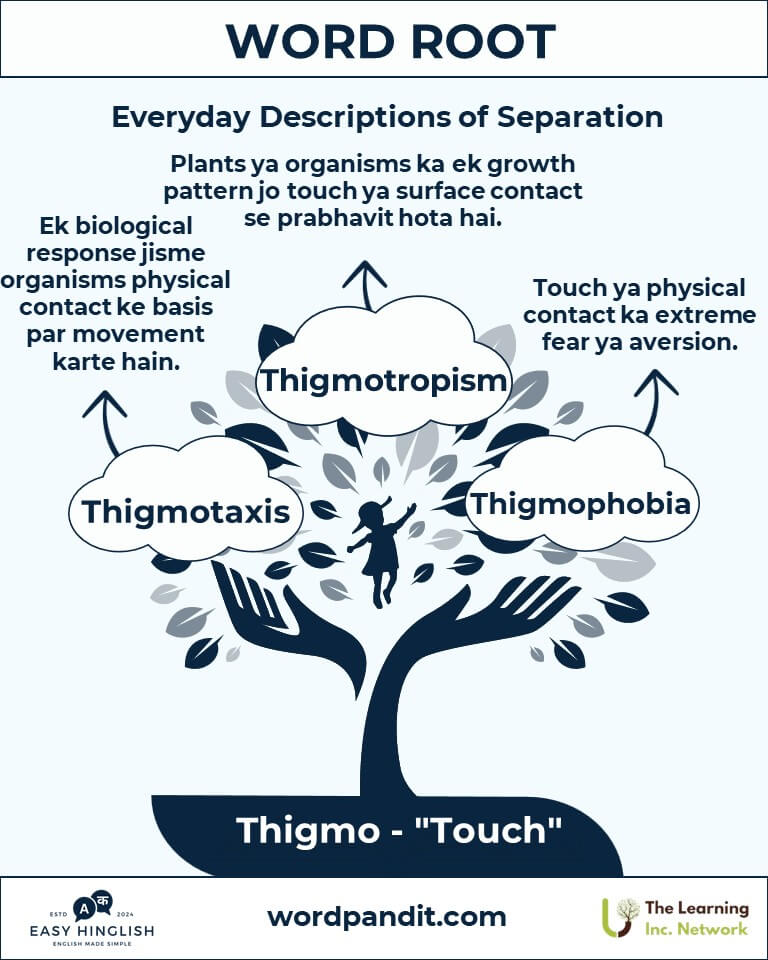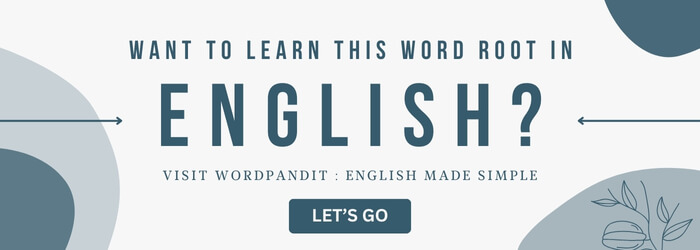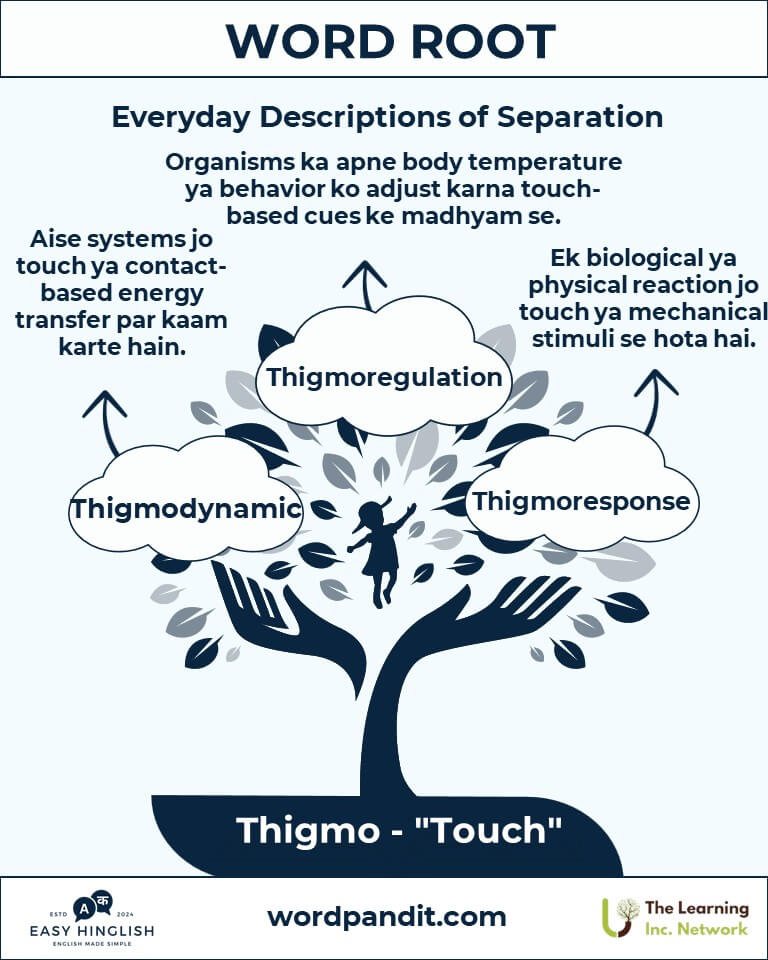Thigmo: The Touch of Life Across Sciences and Beyond
(Thigmo: Zindagi ke Science aur Beyond mein Sparsh ka Mahatva - थिग्मो: ज़िंदगी के साइंस और बियॉन्ड में स्पर्श का महत्व)
Explore the fascinating world of "Thigmo," the word root derived from the Greek "thigma", meaning "touch" (स्पर्श). From biology to psychology, this root highlights the role of tactile interactions in defining growth, behavior, and perception. Discover how words like "Thigmotropism" and "Thigmotaxis" reveal the impact of touch on our understanding of the world.

Table of Contents
- Introduction: The Essence of "Thigmo"
- Etymology and Historical Journey
- Mnemonic: Unlocking the Power of "Thigmo"
- Common Thigmo-Related Terms
- "Thigmo" Through Time
- "Thigmo" in Specialized Fields
- Illustrative Story: "Thigmo" in Action
- Cultural Significance of the "Thigmo" Root
- The "Thigmo" Family Tree
- FAQs About the "Thigmo" Word Root
- Test Your Knowledge: "Thigmo" Mastery Quiz
- Conclusion: The Living Legacy of "Thigmo"
Introduction: The Essence of "Thigmo"
(Thigmo ka Mool Arth - थिग्मो का मूल अर्थ)
Touch (स्पर्श) is one of the most primal and profound senses. The root "Thigmo" (pronounced THIG-moh) originates from the Greek word "thigma", meaning "touch." In scientific and linguistic contexts, this root highlights the role of contact in influencing movement, growth, and behavior.
Example: Whether it is the tendrils of plants curling around support or organisms responding to tactile stimuli, "Thigmo" provides a lens to understand life’s intricate responses to touch.

Etymology and Historical Journey
(Thigmo Root ki Itihaasik Yatra - थिग्मो रूट की ऐतिहासिक यात्रा)
The root "Thigmo" comes from the Greek word "thigma", which was used in ancient texts to describe the act of touching or tactile interaction. Over time, this root became part of scientific nomenclature, leading to the creation of terms like:
- Thigmotropism: The directional growth response of plants to touch.
- Thigmotaxis: The movement of organisms in response to tactile stimuli.
These terms reflect human curiosity about the forces that influence both flora and fauna through physical contact.
Mnemonic: Unlocking the Power of "Thigmo"
(Thigmo yaad rakhne ka trick - थिग्मो याद रखने का ट्रिक)
To remember "Thigmo," imagine a delicate vine wrapping around a sturdy pole—a perfect symbol of touch as a guiding force.
Mnemonic Device: "Thigmo makes things grow and go through the power of touch."
Common Thigmo-Related Terms
(Thigmo se Jude Shabd aur Unka Arth - थिग्मो से जुड़े शब्द और उनके अर्थ)
- Thigmotropism (थिग्मोट्रोपिज़म): The directional growth movement of plants in response to touch.
Example: "Climbing ivy displayed thigmotropism as it wrapped around the garden trellis." - Thigmotaxis (थिग्मोटैक्सिस): The movement of animals in response to tactile stimuli.
Example: "Rats exhibit thigmotaxis by staying close to walls in unfamiliar environments." - Thigmotactic (थिग्मोटैक्टिक): Related to responses triggered by touch stimuli.
Example: "The thigmotactic behavior of insects helps them navigate tight spaces." - Thigmomorphogenesis (थिग्मोमोर्फोजेनेसिस): The process by which plants alter their growth patterns in response to mechanical stimulation, such as touch or wind.
Example: "Frequent brushing can trigger thigmomorphogenesis in young plants, making them sturdier." - Thigmoreceptor (थिग्मोरीसेप्टर): A sensory receptor specialized for detecting tactile stimuli.
Example: "The thigmoreceptors in the skin play an essential role in detecting physical contact."
"Thigmo" Through Time
(Samay ke Saath Thigmo ka Safar - समय के साथ थिग्मो का सफर)
- Thigmotropism in Ancient Botany: Greek philosophers observed plant responses to touch as early as the 4th century BCE.
- Modern Studies on Thigmotaxis: Research in animal behavior has shown that tactile-guided movement influences survival strategies, particularly in rodents and insects.
"Thigmo" in Specialized Fields
(Vishesh Shetron mein Thigmo ka Upyog - विशेष क्षेत्रों में थिग्मो का उपयोग)
- Botany:
Thigmotropism explains how climbing plants, such as peas and ivy, navigate their environment. - Animal Behavior:
Thigmotaxis helps understand stress responses and habitat preferences in various species. - Neuroscience:
Thigmoreceptors play a key role in studying the mechanisms of touch perception. - Agriculture:
Thigmomorphogenesis guides practices such as pruning, which strengthens crops.
Illustrative Story: "Thigmo" in Action
(Thigmo ke Mahatva ki Kahani - थिग्मो के महत्व की कहानी)
One sunny afternoon, Mira watched as her cucumber vines slowly wrapped around garden stakes. It was a perfect example of thigmotropism in action. Meanwhile, in his lab, Dr. Patel was studying cockroaches exhibiting thigmotactic responses. These scenarios showcased how both plants and animals are influenced by touch in their growth and movement.
Cultural Significance of the "Thigmo" Root
(Thigmo ka Sanskritik Mahatva - थिग्मो का सांस्कृतिक महत्व)
In many cultures, touch symbolizes connection and growth. Agricultural societies have long observed and utilized tactile responses in plants and animals for farming techniques. Modern science explores the impact of touch, from tactile therapy to robotics mimicking thigmotactic behavior.

The "Thigmo" Family Tree
(Thigmo Family ke Related Words - थिग्मो परिवार के संबंधित शब्द)
- Tact (Latin: "touch"): Example: Tactile – Related to the sense of touch.
Example: "The sculpture’s tactile surface invited exploration." - Hapto (Greek: "fasten, touch"): Example: Haptic – Based on the sense of touch.
Example: "Haptic technology enhances virtual reality experiences." - Palp (Latin: "feel"): Example: Palpable – So intense that it can almost be physically felt.
Example: "The tension in the room was so palpable that it felt almost physical."

FAQs About the Thigmo Word Root
(Thigmo Root se Jude Prashn aur Uttar - Thigmo
Q: "Thigmo" ka kya matlab hai?
A: "Thigmo" ka matlab Greek shabd "thigma" se hai, jo "touch" (स्पर्श) ko denote karta hai. Iska use plants aur animals ke tactile responses ko explain karne mein hota hai.
Q: Thigmotropism aur Thigmotaxis mein kya fark hai?
A:
• Thigmotropism: Plants ke growth response ko define karta hai jab woh kisi touch stimulus ke contact mein aate hain.
• Thigmotaxis: Animals ke movement aur behavior ko describe karta hai jab woh tactile stimuli ka response dete hain.
Q: Thigmomorphogenesis kya hota hai?
A: Ek process jisme plants apne structure aur growth pattern ko touch ya mechanical stimulation ke response mein adjust karte hain. Example: Hawa ya baar-baar brush hone par plants sturdier aur chhoti growth dikhate hain.
Q: Thigmoreceptors ka kya role hota hai?
A: Thigmoreceptors tactile stimuli detect karne ke liye specialized sensory receptors hote hain jo humans aur animals mein tactile sensations provide karte hain. Yeh pressure, vibration aur surface texture ko feel karne mein madad karte hain.
Test Your Knowledge:Thigmo Mastery Quiz
(Thigmo Quiz ke Zariye Apne Gyaan ko Test Karein - Thigmo क्विज़)
1. "Thigmo" ka matlab kya hai?
2. Thigmotropism kis cheez ko refer karta hai?
3. Thigmoreceptor ka kaam kya hai?
4. Rats thigmotaxis kaise dikhate hain?
Conclusion: The Living Legacy of "Thigmo"
(Thigmo ki Jeevant Virasat - थिग्मो की जीवंत विरासत)
The root "Thigmo" reveals the profound influence of tactile interactions in life. From plants seeking support to animals navigating their surroundings, touch plays a crucial role in understanding the environment. This root constantly reminds us of the power of connection and response.
Takeaway: Continue exploring the world of touch and celebrate the living legacy of "Thigmo" in science and beyond!








